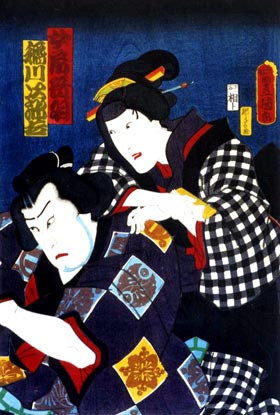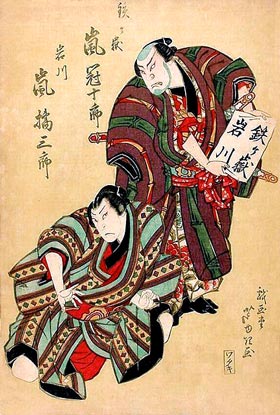| SENRYď NOBORI |
| Play title | Sekitori Senry˘ Nobori The Rise of the 1000 ry˘ Wrestler |
| Common title | Senry˘ Nobori |
| Authors | Chikamatsu Hanji Miyoshi Sh˘raku Takeda Bunkichi Yatami Heishichi Takemoto Saburobŕ II |
| History |
The play "Sekitori Senry˘ Nobori" was originally written for the puppet theater (Bunraku) and staged for the first time in the 8th lunar month of 1767 in ďsaka at the Takemotoza. It was adapted for Kabuki 16 months later and staged for the first time in the 2nd lunar month of 1769 in Edo at the Moritaza [casting]. It was staged for the first time in ďsaka in the 8th lunar month of 1775, produced at the Kado no Shibai by Ogawa Kichitar˘ I [more details]. |
| Structure |
The original drama was in 9 acts. Only two scenes of act II have survived, "Inagawa Uchi" ("at Inagawa's home") and "Sum˘-goya" ("in the small sum˘ arena"). |
| Key words |
Gidayű Ky˘gen Giri/Ninj˘ Kamisuki Miuri Sewamono Sum˘ Sum˘mono Sum˘tori |
| Summary |
Inagawa Jirokichi, a sum˘ wrestler, returns, together with his fellow wrestler Tetsugadake Dadaemon, to his temporary home at Horie in ďsaka where an annual sum˘ tournament is now going on. While he is talking with Tetsugatake over cups of green tea served by his wife Otowa, Kutsuwaya Saemon, a messenger from the ďzakaya teahouse, comes to tell him that he must pay 200 ry˘ before sundown to finalize the ransom of Nishikigi, a courtesan in the employ of the ďzakaya, by his patron Tsuruya Reizabur˘, the son of Tsuruya J˘kyű, one of his major supporters, adding that if he fails to do so the courtesan will be sold to another customer. Leaving this warning, the messenger goes away. In the Edo period, 200 ry˘ was an enormous amount of money. As Reizabur˘'s proxy Inagawa has paid 500 ry˘ to the ďzakaya as the earnest money for Nishikigi's ransom but he has not the 200 ry˘ necessary for the completion of the deal. Inagawa is about to go out to raise money somehow when Tetsugatake stops him, saying that the other customer trying to buy Nishikigi's freedom is none other than his patron Ichihara Kuheita and that he has been entrusted by Kuheita to carry out the transaction on his own. Inagawa, who knows that it is utterly impossible to get so much money in such a short time, implores Tetsugatake to help him by canceling Kuheita's proposal, but Tetsugatake is not only noncommittal but also insults Inagawa by disheveling his hair. A crier comes from the sum˘ association to deliver a list of the day's matches which shows that Inagawa is to confront Tetsugatake. To prepare for the contest Tetsugatake takes his leave after suggesting that he might comply with Inagawa's request if he allows Tetsugatake to win. Should he fulfill his obligation to his supporter (giri), or should he follow his heart and fight honestly (ninj˘)? Though it is an unbearable stain on his honor to be intentionally defeated by Tetsugatake, Inagawa makes up his mind to endure the shame for the sake of his patron to whom he is greatly indebted. Sadly he leaves for the sum˘ arena, seen off by his wife who feels as mortified as her husband. On the ring his contest with Tetsugatake looks most likely to end in Tetsugatake's victory when Inagawa hears an announcement that a patron has offered a gift of 200 ry˘ to him. Now free from his worry about Nishikigi's ransom, Inagawa becomes suddenly vigorous and makes Tetsugatake bite the dust. When the victorious wrestler gets off the ring he is introduced by Shichibŕ of the Kitanoya teahouse to the kind patron who proves to be his wife Otowa. She has sold herself (miuri) to the teahouse to enable her husband sustain his honor. |
 |
 |
|
The actors Kataoka Nizaemon VIII (bottom/left) and Onoe Kikugor˘ IV (top/right) playing the roles of Inagawa Jirokichi and Inagawa's wife Otowa in the drama "Sekitori Senry˘ Nobori", which was staged in the 7th lunar month of 1859 at the Nakamuraza (print made by Utagawa Toyokuni III) |
The actors Arashi Kitsusabur˘ II (bottom/left) and Arashi Kanjűr˘ I (top/right) playing the roles of Iwagawa and Tetsugadake in the drama "Sekitori Senry˘ Nobori", which was staged in the 9th lunar month of 1827 at the Naka no Shibai (print made by Asayama Ashiyuki) |
|
|
| Contact | Main | Top | Updates | Actors | Plays | Playwrights | Programs | Links | FAQ | Glossary | Chronology | Illustrations | Prints | Characters | Derivatives | Theaters | Coming soon | News |